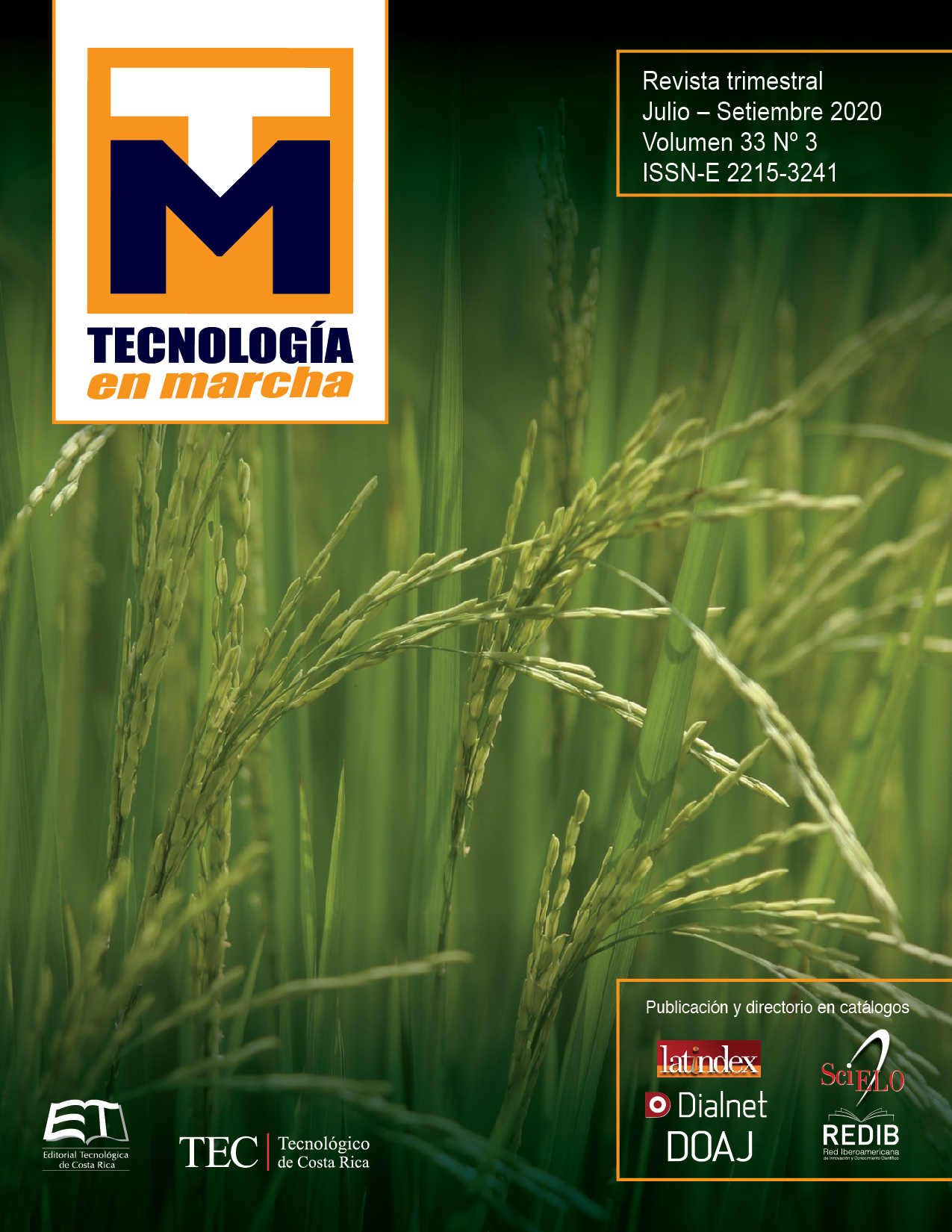Evaluation of planting density and level of fertilization in rice, for the varieties Palmar-18, Lazarroz FL and NayuribeB FL, in Parrita (central Pacific), Costa Rica
Main Article Content
Abstract
The materials released in Costa Rica for rice cultivation (Oryza sativa L.) to date do not receive a differentiated management from producers of the central Pacific and south zone of Costa Rica, despite the high variability in the level of tillering and the productive capacity. To determine the effect of different sowing densities and different levels of fertilization on the yield of rice (Oryza sativa L.) an assay was carried out in the farm La Ligia, which is owned by the company DAPASA, in Parrita, Puntarenas. The experimental design was randomized, of complete blocks with nine treatments and three repetitions, one for each of the varieties (Palmar 18, Lazarroz FL and NayuribeB FL). The treatments compared three planting densities (75, 115, and 155 k seed / ha) and 3 fertilization levels of N-P-K (50-50-50, 100-50-0, 100-50-100 kg / ha). The variables evaluated were yield (ton / ha SL), number of tillers / plants, number of panicles / m², number of full grains, and weight of 1000 grains, all of them evaluated in the harvest of the 1st dry season in year 2017. For all treatments, significant findings were achieved. Planting density of 155 kg seed / ha allowed the best yields for the three varieties. Crop yield in every variety was improved after 100-50-100 kg fertilizer / ha was supplied. Lazarroz FL yielded at highest rates (ton / ha SL), followed by NayuribeB FL and Palmar 18.
Article Details

This work is licensed under a Creative Commons Attribution-NonCommercial-NoDerivatives 4.0 International License.
Los autores conservan los derechos de autor y ceden a la revista el derecho de la primera publicación y pueda editarlo, reproducirlo, distribuirlo, exhibirlo y comunicarlo en el país y en el extranjero mediante medios impresos y electrónicos. Asimismo, asumen el compromiso sobre cualquier litigio o reclamación relacionada con derechos de propiedad intelectual, exonerando de responsabilidad a la Editorial Tecnológica de Costa Rica. Además, se establece que los autores pueden realizar otros acuerdos contractuales independientes y adicionales para la distribución no exclusiva de la versión del artículo publicado en esta revista (p. ej., incluirlo en un repositorio institucional o publicarlo en un libro) siempre que indiquen claramente que el trabajo se publicó por primera vez en esta revista.
References
Organización de las Naciones Unidas para la Alimentación (FAO), “Hacia la elaboración de una estrategia de asistencia técnica de la FAO en apoyo a la implementación de la Iniciativa América Latina y el Caribe Sin Hambre”, Ciudad de Guatemala, 2016.
Instituto Nacional de Estadística y Censos (INEC), “VI Censo Nacional Agropecuario; resultados generales”, 2014 [en línea]. Disponible en http://www.mag.go.cr/bibliotecavirtual/a00338.pdf.
M. Acevedo Barona et al., “Efectos de la densidad de siembra y fertilización nitrogenada sobre el rendimiento de granos de arroz del cultivar centauro en Venezuela”, Agronomía Tropical, vol. 61, no. 1, pp. 15-26, 2011.
R. Tinoco y A. Acuña, “Manual de recomendaciones técnicas del cultivo de arroz (Oryza sativa)”, San José, Costa Rica: INTA, 2008 [en línea]. Disponible en http://www.mag.go.cr/bibliotecavirtual/a00177.pdf.
CONARROZ, “Informe estadístico periodo 2016/2017”, Unidad de Inteligencia de Mercados, Dirección de Operaciones, Costa Rica, 2016 [en línea]. Disponible enhttps://www.conarroz.com/UserFiles/File/INFORME_ANUAL_ESTADISTICO_PERIODO_2016_2017.pdf
D. Guzmán, “Manejo agronómico del cultivo de arroz (Oryza sativa L.) sembrado bajo riego en finca Ranchos Horizonte”, Cañas, Guanacaste, Costa Rica, pp. 6-8, 2006.
FAO, “Agricultura mundial hacia los años 2015/2030”, Roma, Italia, 2002 [en línea]. Disponible en http://www.fao.org/docrep/004/y3557s/y3557s00.htm#TopOfPage
H. Jiménez, “Anatomía del sistema de clasificación de Holdridge”, Turrialba, Costa Rica, 1982.
R. Mata, A. Vásquez y A. Rosales, “El mapa de suelos de Costa Rica con leyenda WRB”, 2016.
CONARROZ, “Reglamento interno del mecanismo para la valoración del arroz en granza”, 2004 [en línea]. Disponible en http://www.conarroz.com/UserFiles/File/Transparencia/MECANISMOparaLaVALORACIONdelARROZenGRANZAparaCOSTA%20RICA.pdf
CONARROZ, “Informe estadístico período 2016/2017”, Unidad de Inteligencia de Mercados, Dirección de Operaciones, 2017.
CONARROZ, “Factores claves en el manejo de arroz de secano”, San José, Costa Rica, 2005 [en línea]. Disponible en http://www.conarroz.com/pdf/Factores%20claves%20en%20el%20manejo%20de%20arroz%20de%20secano.pdf
R.C. Chaudhary, J. S. Nanda y D.V. Tran, “Guía para identificar las limitaciones de campo en la producción de arroz”, FAO, Roma, Italia, 2003.
Potash & Phosphate Institute, “Identificación de los problemas nutricionales en arroz”, 2017 [en línea]. Disponible en https://ipni.net/ppiweb/gltamn.nsf/$webindex/E4B79420325A209705256ECB004BDE01?opendocument&print=1
J. Rodríguez, “Fertilización del cultivo de arroz (Oryza sativa L.)”, XI Congreso Nacional Agronómico, pp. 1-14, 1999.
G. Meléndez y E. Molina, “Fertilidad de suelos y manejo de la nutrición de cultivos en Costa Rica”, Centro de Investigaciones Agronómicas, pp. 92-103, 2001.
Instituto Internacional de Nutrición de Plantas, “Requerimientos nutricionales de los cultivos”, Archivo Agronómico no. 3, 2002 [en línea]. Disponible enhttp://lacs.ipni.net/topic/agronomic-files.
R. Ramírez, “El uso eficiente de los fertilizantes y el incremento de la productividad agrícola en Venezuela”, Agronomía Tropical, vol. 40, 1990 [en línea]. Disponible en http://www.sian.inia.gob.ve/revistas_ci/Agronomia%20Tropical/at4013/pdf/ramirez_r.pdf
E. Molina y J. Rodríguez, “Fertilización con N, P, K y S, y curvas de absorción de nutrimentos en arroz var cfx. 18 en Guanacaste”, Agronomía Costarricense, 2012.

